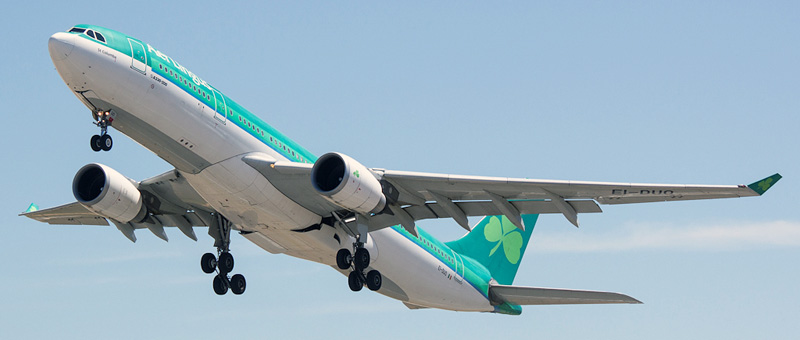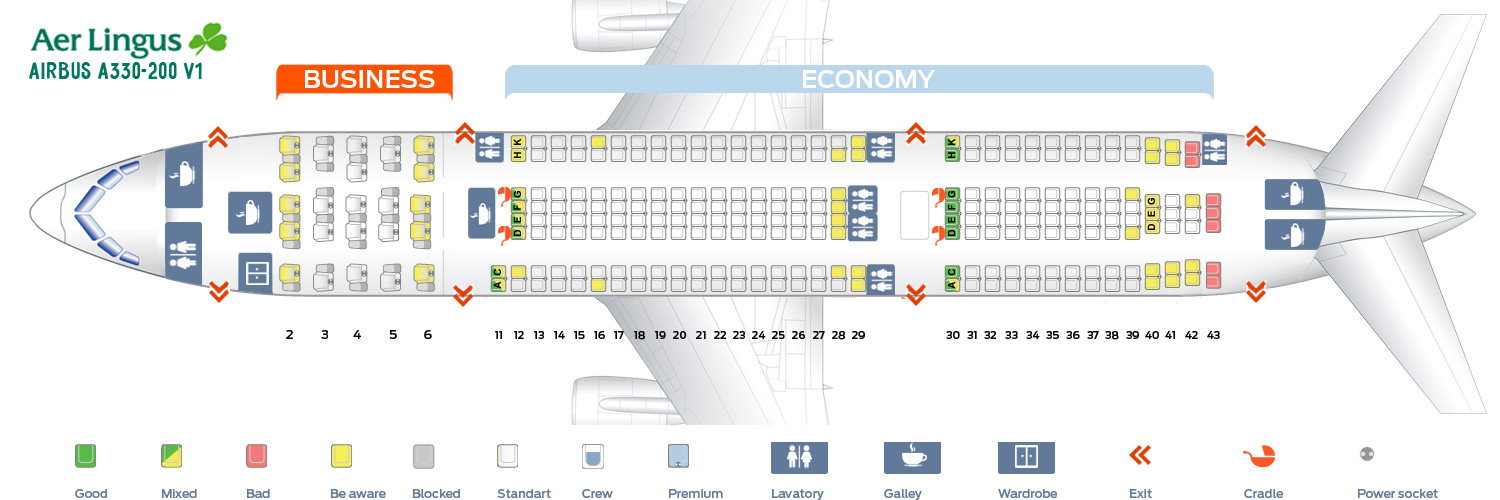
Seat map Airbus A330-200 “Aer Lingus”. Best seats in the plane
Aer Lingus operates 2 versions of Airbus A330-200.
First cabin version of the Airbus A330-200 (332) V1
First version of Airbus A330-200 operated by Aer Lingus is the most common. It may accommodate 271 passengers in two classes: business and economy.
Business class consists of 23 flat bed seats. Noise that is coming from the galley will cause discomfort to passengers of the seats of the 2nd row. Also these seats have no floor storage during take-off and landing.
Position of the seats 2A, 4A, 4G, 4 H, 5D, 6A and 6H to the aisle may also cause discomfort. The seats 3A, 3G, 3K, 4D, 5A, 5G, 6D have additional space for storage in form of console and offer some privacy.
For passengers that need privacy during the flight will be ideal the seats 3K and 5K.
Close location to the lavatory and galley may cause inconvenience to passengers of the seats of the 6th row.
Behind the exit row economy class seats are located. Economy class is divided into two sections.
First section consists of 19 rows of seats. Most of them have 2-4-2 configuration.
Passengers of the seats 11AC will take advantage of extra space for their legs. Among disadvantages of these seats: proximity of the galley and lavatory, reduced width and lack of floor storage during take-off and landing.
Aer Lingus designates the seat 12C as a Choice seat. Entertainment equipment stored under this seat restricts legroom, close location of the galley may also cause discomfort.
Passengers traveling with infants are often seated on the seats 12DEFG as they have bassinet locations. These seats offer extra legroom but are narrower than standard, have no floor storage during take-off and landing. Proximity of the galley is another disadvantage of these seats.
The seats 12HK are designated as Choice seat. These seats have limited legroom, are located close to the galley and lavatory. As the tray tables are in the armrests, the width of these seats is reduced a little. Also these seats have no floor storage during take-off and landing.
The seats 16A and 16K have misaligned windows. Other passengers tend to congregate in the air of the seats 28C, 28DEFG, 28H and the seats of the 29th row while waiting to use lavatories. Limited recline is another disadvantage of the seats 28DEFG, 29AC and 29HK.
Behind another exit row the second section of economy class seats is located.
Thanks to the exit row located in front the seats of the 30th row offer extra legroom. The tray tables are in the armrests making them immovable and reducing the width of these seats. Lack of floor storage may also represent a problem. As the exit door protrude inside the legroom of the seats 30A and 30K is restricted a little.
As there are no seats behind the seats 39D and 39G are often bumped by other passengers and crew members passing by.
The seats 40AC, 41AC, 42AC, 40HK and 41HK feel narrower because of the curvature of the airplane.
Because of the misaligned seats the seats 40DEG have less legroom. These seats offer extra storage space. as the tray tables are built-in the armrests the width of these seats is reduced a little.
Close location to the lavatory will cause discomfort to passengers of the seats 42G, 42HK and 43G. Limited recline makes the seats 42HK and the seats of the last 43th row bad seats.
Second cabin version of the Airbus A330-200 (332) V2
Second version of Airbus A330-200 may transport 266 passengers. There are two classes of seats here: business and economy.
Business class has 5 rows of seats. There are totally 23 flat-bed seats here.
The noise that is coming from the galleys may disturb passengers of the seats of the 2nd row. These seats have no floor storage during take-off and landing. Proximity of the galley and lavatories is also a main disadvantage of the seats of the 6th row.
Position of some seats to the aisle may be bothersome. These are the following seats: 2A, 2G, 2H, 4A, 4G, 4H, 5D, 6A and 6H.
Presence of console is an advantage as it may be used for storage and it protects from the aisle activity. Such console have the following seats: 3G, 3K, 4D, 5A, 5G, 5K and 6D.
Economy class consists of 243 standard seats. The seats of the economy class are divided into two sections.
First section includes 18 rows of seats. Most of them have 2-4-2 configuration.
Passengers of the seats of the 11th row will feel comfortable thanks to extra legroom. Among disadvantages of these seats: close location of the lavatory and galleys, as the tray tables are in the armrests the width of these seats is reduced a little. Lack of floor storage during take-off and landing is another disadvantage. Passengers traveling with babies are often seated on the seats 11DEG as they have bassinet locations.
The seats 12DEFG are narrower than standard and have limited legroom because of the transitions of the seats from 3 to 4.
Other passengers tend to gather in the area of the last rows of the section while waiting to use lavatories and causing discomfort to passengers of the seats 27C, 27H, 28AC and 28HK. Limited recline is one more disadvantage of the seats of the 28th row.
Behind exit row the second section of economy class seats is located.
Due to the exit row located in front the seats of the 29th row offer extra space for passengers’ legs. However, these seats are narrower than standard and have no floor storage during take-off and landing.
The seats 29DEFG are first reserved for passengers with infants as they have bassinet locations.
As the seats 38D and 38G jut out into the aisle, they are often bumped by other passengers and crew members passing by.
The seats 39DEG have limited legroom but extra storage space. As the tray tables are in the armrests the width of these seats is reduced.
Because of the curvature of the airplane the seats AC, HK of the rows 39-41 feel narrower and cramped.
Limited recline makes the seats of the 42nd row bad seats.
Usefull information about “Aer Lingus”
- Rating and reviews about “Aer Lingus”
- Airbus A330-200 Aer Lingus. Photos and description of the plane
- Aer Lingus – company description and aircrafts fleet


